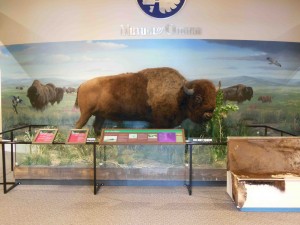where the buffalo roam
On Saturday, August 30, the Smithsonian’s National Zoo will bring back the American bison in a new exhibit and habitat. Zora and Wilma are not only beautiful animals, but they also serve as an important reminder about conservation and the Zoo’s inception. In 1887, American bison wandered the National Mall, helping to bring awareness to the endangerment of the species. Two years later, Congress passed legislation to found the National Zoo, celebrating its 125th anniversary this year.
At Affiliations, we are wallowing in the excitement of welcoming these magnificent animals to Washington. So we decided to scan our herd of partners, to see where else the mighty American bison are roaming among Affiliate plains. We found a virtual stampede of bison content in Affiliateland!
– It seems appropriate to start in Wyoming, at the Buffalo Bill Center of the West. After all, it was “Buffalo Bill” Cody who offered the Smithsonian a herd of 18 bison in 1888. Painfully, the gift had to be refused for lack of space on the National Mall. But today, you can find plenty of bison material at the Buffalo Bill Center in Cody. The Center’s museums house an impressive collection of art depicting “Nature’s Cattle,” including beautiful Audubon prints as well as Native artifacts made from the bison, and natural history specimens.
– It was a Nebraska rancher who donated the very first bison to the Smithsonian’s collection, so it seems natural to travel on to Omaha to visit “Scout,” the beloved bison on view at the Durham Museum. At 7 ½’ high and 10’ long, this magnificent specimen helps to tell the important story of the Midwest’s history with the bison. As part of their bison interpretation, the Durham Museum uses the online resource Tracking the Buffalo from the National Museum of American History. Go ahead – take the site’s interactive test to guess what you could make from all the parts of the animal.
– Some bison though, were revered beyond all that they could provide for Native people. A white bison is extremely rare, appearing once in approximately five million births. For this reason, these animals are considered sacred and possess great spiritual power to Native and non-Native people alike. Given this extreme rarity, where could you ever see one now?! The Montana Historical Society in Helena displays “Big Medicine,” a white buffalo who died in 1959. With blue eyes, tan hooves, and a brown topknot, there’s still plenty of reasons to revere the beauty of this extraordinary specimen today.
– As rare as Big Medicine is, perhaps no bison has the hometown spirit of “On the Wind,” the massive bronze bison who greets visitors to the History Colorado Center in Denver. He’s been seen wearing bandannas when the stock show comes to town, a Broncos jersey during football season, and even a bike helmet during the recent Pro Challenge cycling race through the state. He’s also an important reminder of the stories told inside the Center about the historic relationship between bison and the peoples of the West.
– To travel even further back in time, check out the archeological remains of a gigantic Ice Age bison at the Denver Museum of Nature and Science. Excavated from the Colorado Rockies, this iconic specimen and its neighbors represent one of the most significant fossil discoveries ever made in Colorado. How gigantic was it? Twice the size of a modern bison! How do we know? It had a horn spread more than 7’ wide (compared with the 2 ½’ spread of the modern buffalo).
– If you’re finding it hard to imagine the size of a modern bison without actually seeing one, the South Dakota State Historical Society can help you out. They’ve devised a fun 30-page coloring sheet called How Big is a Buffalo. Bison make quite an appearance in the Society’s education kits, which include objects, lesson plans, worksheets and ideas for additional activities. The Buffalo and Plains Indians, Lewis and Clark, and Archeology kits are just a few that explore all facets of this great American species.
– Lest you think the Affiliate bison only roam west of the Mississippi, think again. The Mashantucket Pequot Museum in Connecticut is currently displaying The Bison: American Icon exhibition, which explores “the dramatic changes that occurred to the bison and its habitat, and to the people who depended on it for their daily existence.” At the end of September, the Museum invites visitors to take the Bison Challenge – an outdoor activity that will test your speed, strength, and senses against the performance of a bison. Good luck!
As the song goes, “oh give me a home. “ It’s gratifying to see how many Affiliate “homes” across America celebrate the iconic bison, and that the Smithsonian will soon provide two of them a home in the nation’s capital.
How does your museum interpret the mighty bison? (We’re looking at you Idaho and Oklahoma) Tell us your stories!
(Footnote: “bison” and “buffalo” are often used interchangeably. Culturally this is correct; scientifically it is not. Technically, bison and buffalo are not the same animal. Click here to compare their differences.)
 The author is a National Outreach Manager in Smithsonian Affiliations, and a long-time buffalophile.
The author is a National Outreach Manager in Smithsonian Affiliations, and a long-time buffalophile.







